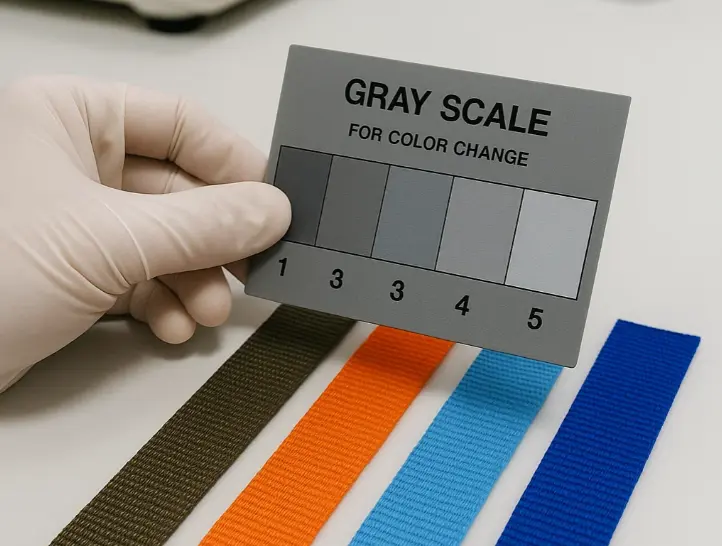Have you ever faced this problem? Your carefully designed product looks great, but after some use, its webbing straps become dull, patchy, or even bleed color onto other materials. This doesn't just ruin the product's appearance; it directly damages your customers' trust in your brand. The root cause of this issue is "color fastness."
For brands in the outdoor gear, marine, high-end apparel, and pet supply industries, the color durability of webbing is a critical quality benchmark. As your manufacturing partner, we understand this completely. This in-depth guide will reveal the secrets behind webbing color fade and explain how we ensure your product’s color remains steadfast and true.
What Exactly Is Color Fastness?
In simple terms, color fastness is a measure of how well a fabric's color holds up against various external factors. It assesses the ability of your webbing to resist fading (losing its own color) and crocking (rubbing its color off onto other surfaces). A product with high color fastness will remain vibrant and stable, even in harsh conditions.
The Three Main Culprits Behind Fading Webbing
A webbing strap's color stability is primarily challenged by these three common factors:
1. Sunlight (Light Fastness)
This is the number one enemy for outdoor and military gear. The ultraviolet (UV) radiation in sunlight is a powerful "color killer." It breaks down the chemical structure of dyes, causing the color molecules to decompose, which leads to visible fading and discoloration. For products constantly exposed to the sun, like backpacks, tents, or marine ropes, choosing webbing with high light fastness is non-negotiable. Our Polyester Webbing, for instance, is highly recommended for its excellent UV resistance.
2. Washing (Wash Fastness)
For apparel, pet collars, or any product that requires regular cleaning, wash fastness is key. During laundering, the combination of water, detergents, and mechanical action can cause dye molecules to detach from the fibers. A low-quality dyeing process will result in significant color loss even after the first wash, potentially staining other items in the load.
3. Friction (Crocking or Rubbing Fastness)
Rubbing fastness is evaluated in two states: dry and wet. Imagine a dark-colored backpack strap rubbing against a light-colored t-shirt all day. If the webbing has poor crocking fastness, the t-shirt's shoulder will likely be stained. The risk is even higher with wet rubbing (e.g., when soaked with sweat or rain). This is a critical concern for garment accessories and products that have direct contact with skin.
How We Quantify Color Fastness: The AATCC Standards
Verbal promises are empty; true quality is verified through standardized testing. In the textile industry, we rely on internationally recognized standards, such as those from the AATCC (American Association of Textile Chemists and Colorists), to grade color fastness. The results are typically rated on a scale:
- Grade 5: Excellent, no change or color transfer.
- Grade 4: Good, very slight change or transfer.
- Grade 3: Fair, noticeable change or transfer.
- Grades 1-2: Poor, significant change or transfer.
For premium brands, webbing should achieve a grade of 4 or higher on key metrics like light, wash, and rubbing fastness.
The TMG Webbing Promise: How We Ensure Superior Color Fastness
Understanding the causes of fading is one thing; solving the problem at the source is what matters most. For us, ensuring color durability is a systematic quality control process.
1. We Start with High-Quality Dyes
It all begins with the raw materials. We exclusively use eco-friendly dyes from top global suppliers. These dyes not only produce vibrant colors but also have stable molecular structures that form strong chemical bonds with fibers like Nylon and Polyester. This fundamentally improves their resistance to breaking down or washing out.
2. We Use Advanced Dyeing Processes
We employ a high-temperature, high-pressure yarn dyeing process. This means we dye the yarn *before* it is woven into webbing. Compared to the cheaper method of piece-dyeing (dyeing the white webbing after it's woven), yarn dyeing allows the dye molecules to fully penetrate and lock into the core of every fiber. This dramatically improves color fastness. The principle is similar to that of Jacquard webbing, where the color is an integral part of the fabric's structure, not just a surface application.
3. We Conduct Rigorous In-House and Third-Party Testing
Every batch of custom-colored webbing undergoes stringent color fastness tests in our in-house lab, simulating real-world conditions like sun exposure, washing, and friction. Furthermore, upon request, we can send product samples to accredited third-party labs like SGS or Intertek for verification. This provides you with an objective, reliable quality report and ensures compliance with market regulations like REACH or California Proposition 65.
A single strap carries the weight of your brand's reputation. Its color durability is a silent message to your customers: "We care about details. We stand for quality." Choosing a supplier that prioritizes color fastness is an investment in your brand's future. If you have questions about selecting the webbing with the best color fastness for your product, contact our team of experts today. We are ready to share our knowledge to help you succeed.

